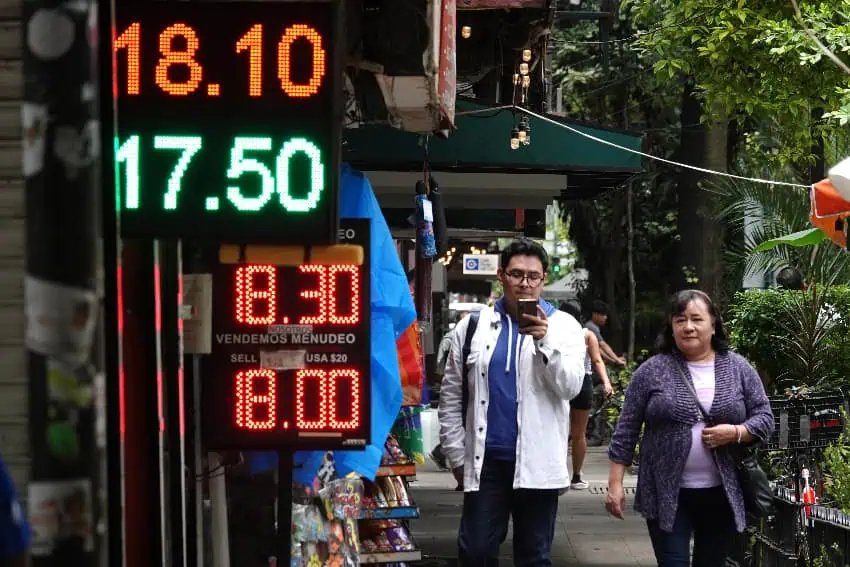The Mexican peso appreciated to below 18 to the US dollar on Monday morning after data showed that inflation was higher than expected in the first half of June.
Bloomberg data shows that the peso reached 17.88 to the greenback at 11:45 a.m. Mexico City time just hours after the national statistics agency INEGI reported that annual headline inflation in Mexico was 4.78% in the first 15 days of June, up from 4.59% in the previous two-week period and 4.69% across May.

The currency, which closed at 18.11 to the greenback on Friday, also benefited from a slight general weakening of the dollar.
The inflation rate in the first half of the month is 0.05 percentage points higher than the 4.73% median forecast of analysts surveyed by Bloomberg.
The higher-than-expected reading increases the probability that the Bank of Mexico board — which is targeting 3% inflation — will vote to maintain the central bank’s official interest rate at 11% at its monetary policy meeting this Thursday.
Such a decision would benefit the peso as it would not narrow the differential between the Bank of Mexico’s benchmark interest rate and that of the United States Federal Reserve, currently set at a 5.25%-5.5% range.

The peso has benefited for an extended period from the wide gap between official interest rates in the two countries, but it took a hit after the results of the June 2 elections in Mexico put the ruling Morena party in a strong position to approve a package of constitutional reform proposals President Andrés Manuel López Obrador sent to Congress earlier this year.
The currency strengthened late last week after President-elect Claudia Sheinbaum announced her first cabinet picks, including Marcelo Ebrard as economy minister. Even with the additional appreciation on Monday morning, however, the peso remains over 5% weaker than it was before the elections.
High prices for fresh produce and services fuel inflation
INEGI data shows that inflation for fruit and vegetables, and services, remains stubbornly high.
Fruit and vegetables were 17.28% more expensive in the first 15 days of the month than in the first half of June 2023.
Annual inflation for agricultural products more broadly was 8.99%. That figure was tempered by the comparatively low 2.46% inflation rate for meat.
The price of some fresh produce increased significantly compared to the previous two-week period, as drought continues to have an impact on food prices.
Chayotes, for example, were 79% more expensive than in the second half of May, while prices for oranges increased 19% and lettuce and cabbage were 15% dearer. Banana prices spiked 11%, while avocados were almost 8% more expensive.
Meanwhile, annual inflation for services was 5.19% in the first half of June, while processed food, beverages and tobacco were 4.28% more expensive.
Electricity prices including gasoline increased 4.74%, while non-food goods were 2.18% more expensive.
The closely-watched annual core inflation rate, which excludes volatile food and energy prices, was 4.17% in the first half of June, up from 4.11% in the second half of May, but down from 4.21% across last month.

The rate was slightly lower than the 4.18% median forecast of analysts surveyed by Bloomberg.
Jessica Roldán, chief economist at the Finamex brokerage, said that the headline inflation rate was “worse than expected because the reported increase in the fruits and vegetables component was much greater than anticipated.”
The impact of those prices on inflation could “last for longer not only because of the prolonged period of dry weather that we’ve seen, but because in the future other factors — such as stronger rains in parts of the country — could also affect crops,” she said.
Recent depreciation of the peso will also influence Banxico’s rate decision
In addition to inflation — which has been on the rise since March — the Bank of Mexico (Banxico) “must now also consider the upside risks to inflation from the peso’s depreciation,” Bloomberg reported.
Kimberley Sperrfechter, an emerging markets economist at London-based Capital Economics, wrote in a note that “the continued strength in core services inflation in Mexico in the first half of June, combined with the post-election slump in the peso and heightened political uncertainty, means that Banxico is unlikely to restart its easing cycle at Thursday’s Board meeting.”
Gabriela Siller, director of economic analysis at Mexico’s Banco Base, believes that a majority of the central bank’s board will vote to maintain the 11% interest rate due to factors including the recent depreciation of the peso.
“The quick depreciation of the peso could generate inflationary pressures, but they’re not always of the same magnitude, so it would be prudent to wait and see,” she said.
“Going forward, we think … [the Banxico board is] going to cut twice more in the year, but toward the end of the year, when conditions are better,” Siller said.
The bank made an initial cut to what was a record-high 11.25% interest rate in March.
Another consideration for the central bank’s board this Thursday will be data that shows that the Mexican economy grew just 0.9% in annual terms in April, down from 3.3% in March.
With reports from El Economista, Bloomberg and El Financiero
